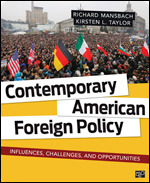

Contemporary American Foreign Policy
Influences, Challenges, and Opportunities
- Richard Mansbach - Iowa State University, USA
- Kirsten L. Taylor - Berry College, USA
American Foreign Policy
Contemporary American Foreign Policy: Influences, Challenges, and Opportunities looks at today’s most pressing foreign-policy challenges from a U.S. perspective, as well as from the vantage point of other states and peoples. It explores global issues such as human rights, climate change, poverty, nuclear arms proliferation, and economic collapse from multiple angles, not just through a so-called national interest lens. Authors Richard Mansbach and Kirsten L. Taylor shed new light on the competing forces that influence foreign-policy decision making, outline the various policy options available to decision makers, and explore the potential consequences of those policies, all to fully grasp and work to meet contemporary foreign-policy challenges.
Supplements
SAGE edge offers a robust online environment featuring an impressive array of tools and resources for review, study, and further exploration, keeping both instructors and students on the cutting edge of teaching and learning. SAGE edge content is open access and available on demand. Learning and teaching has never been easier!
SAGE edge for Students provides a personalized approach to help students accomplish their coursework goals in an easy-to-use learning environment and features elements such as:
- Mobile-friendly eFlashcards which strengthen understanding of key terms and concepts
- Mobile-friendly practice quizzes that allow for independent assessment by students of their mastery of course material
- An online action plan includes tips and feedback on progress through the course and materials, which allows students to individualize their learning experience
- Chapter summaries with learning objectives that reinforce the most important material
- Carefully selected video and multimedia content that enhance exploration of key topics
SAGE edge for Instructors, supports teaching by making it easy to integrate quality content and create a rich learning environment for students.
- Test banks that provide a diverse range of test items with Respondus test generation
- Editable, chapter-specific PowerPoint® slides offer complete flexibility for creating a multimedia presentation for the course
- Video and multimedia content that enhance student engagement and appeal to different learning styles
- Instructor manual which summarize key concepts by chapter to ease preparation for lectures and class discussions
- Chapter-specific discussion questions help launch classroom interaction by prompting students to engage with the material and by reinforcing important content
- Lively and stimulating assignments and exercises that can be used in-class or online teaching to reinforce active learning and key features from the text. The activities apply to individual or group projects
- A set of all the graphics from the text, including all of the maps, tables, and figures, is available in PowerPoint, pdf, and JPEG formats for class presentations
“Mansbach and Taylor’s practical, solution-oriented approach is novel and valuable. Its use of levels of analysis for causal factors and the way that it conscientiously includes important components of the global environment often neglected in other texts are just some of the factors that set it apart.”
“Manbach and Taylor enliven the subject matter and make it relevant to current situations. Each chapter provides an effective overview of the historical context and contemporary importance of a significant foreign policy issue, providing needed perspective that combines strong scholarship and engaging writing.”
“Mansbach and Taylor provide a thoroughly up-to-date, useful pedagogical tool for studying and learning about U.S. foreign policy. Contemporary American Foreign Policy is particularly strong in its assessments of the opportunities and constraints relative to various foreign policy options presented to the American Foreign Policy Establishment. Its strongest assets lie in its incorporation of an issue areas–approach to foreign affairs and in its various case studies.”
“Mansbach and Taylor present a timely, comprehensive, and engaging text, involving readers in the evaluation of each policy by showing positive and negative outcomes, as well as policy alternatives and approaches for analysis. Contemporary American Foreign Policy will be attractive to both upper division and lower division undergraduates alike.”
